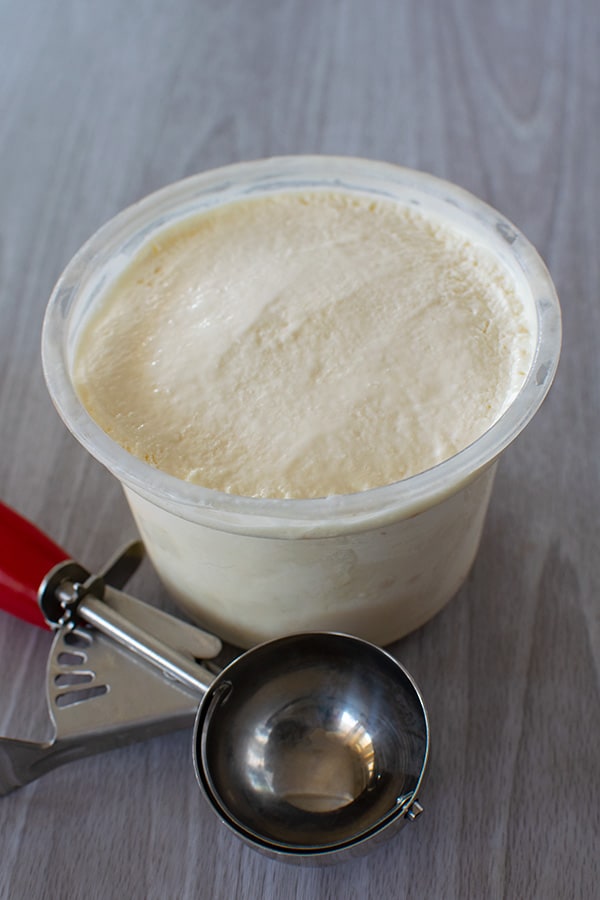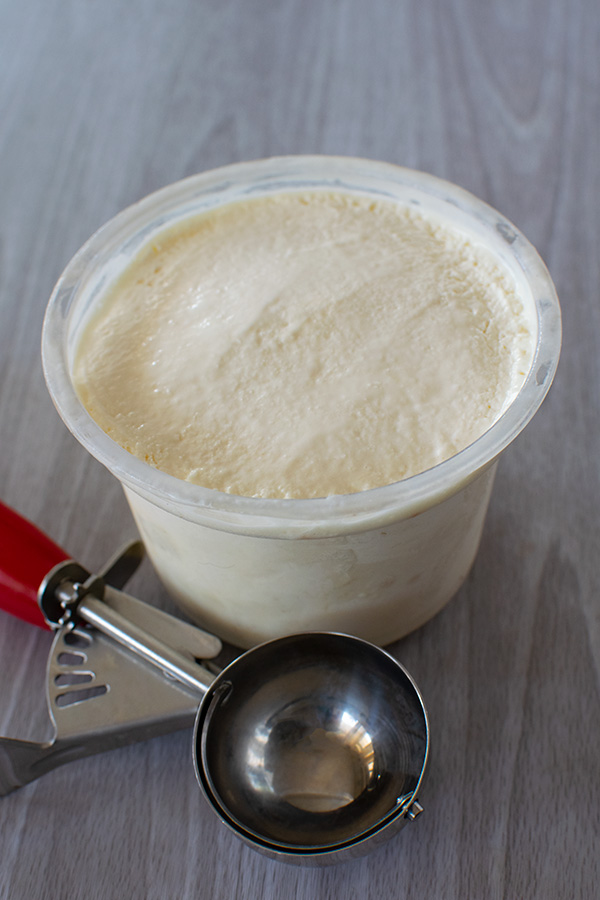Vanilla Ice Cream for Passover is a 4-ingredient, homemade, delicious frozen dessert. Use dairy-free cream, and voila! A dairy-free dessert!

Vanilla Ice Cream for Passover is a no-cook, no-churn soft frozen dessert that is simple to make. Just mix and freeze. And have it at the ready for a refreshing and delicious dessert any time during the holiday.
In fact, it’s perfect for the day of the seder since there is, of course, no matzo in the ingredients!
Eating matzo on the day of the seder
Jews who keep the laws of Passover do not eat matzo or any foods that contain anything from matzo (such as matzo meal or matzo cake meal) the entire day before the seder, which is in the evening.
Some people even have the custom of not eating such foods from two weeks before, beginning on Rosh Chodesh Nissan or even as far back as Purim, which is a month before.
Food on Passover
Torah-observant Jews do not eat chametz (the fermented products of five grains: wheat, spelt, barley, oats, and rye).
In addition, Torah-observant Ashkenazi Jews do not eat kitniyot (or kitniyos as pronounced in Ashkenazi Hebrew). These include legumes, corn, rice, and similar foods that were deemed forbidden to eat by rabbis in the medieval period and are still not eaten today. Sephardi and Mizrachi Jews do not follow this tradition.
Many observant Ashkenazi Jews will not even eat the derivatives of these kitniyot, while others do (each family holds their own traditions regarding this).
Then, there are Ashkenazim who don’t eat “gebrokts” (or gebrochts).
Gebrokts (gebrochts) means “broken” in Yiddish, and in this case refers to matzo that has absorbed liquid. Not eating gebrokts is observed by many in the Hasidic Jewish community and Ashkenazim who have taken on this tradition where they basically don’t mix anything wet with matzo.
So, things like matzo sandwiches, fried matzo, and even matzo balls are a no-no for them.
There is a joke that sums it all up:
On Passover, we should remember people who have little to eat on this holiday. They are called Ashkenazim.
Over the years, I have learned to adapt “normal” food for Passover so that my family won’t complain about boring, tasteless, or repetitive meals.
I find that having good food and variety makes the week of Passover a very pleasant experience, and I hope this recipe will help make yours just that!
Baking and dessert necessities for Passover
I like to make sure I can bake anything with very short notice. To that end, I keep a variety of supplies and ingredients in the house that will allow me to do just that.
I can’t tell you how many times I was glad to have whatever I needed within reach for the last minute visitor or for when one of my kids went to a friend or had a school event without much prior notice.
I have slowly collected things over the years as I needed them (or if I found a good sale) and like to keep more than one of the smaller items, in case I don’t want to wash dishes in the middle of baking.
My basic “equipment” includes:
- a hand mixer (you probably don’t need a stand mixer for Passover)
- a small scale
- baking pans
- mixing bowls (or just large bowls)
- cookie sheets
- dry measuring cups
- liquid measuring cups
- whisks
- rubber spatulas (really good for when you don’t want to leave anything in the bowl)
- baking (or parchment) paper
While you can certainly manage without the above (such as a whisk, where you can use a fork in a pinch), if you tend to do a lot of Passover baking, these are good to have around.
In addition to the equipment, there are several basic baking ingredients that are used regularly if you are going to want to bake and may be helpful to have at the beginning of the holiday.
Just make absolutely certain that they have a Kosher for Passover certification or don’t require one. When in doubt, ask an orthodox rabbi (there are also some orthodox organizations that post Passover information online).
Some of the items on this list, however, are not basic, but rather are only used for specific recipes. Regarding these, you might not want to invest in them in advance, but only if you need them.
Unless you have been making Passover at home and know which is which, you might want to plan ahead, at least until you get used to what your yearly baking needs are.
- matzo cake meal
- potato starch
- white sugar
- brown sugar
- powdered sugar
- salt
- baking powder (leavens chemically, so it just needs to be certified Kosher for Passover)
- baking soda (leavens chemically, so it just needs to be certified Kosher for Passover)
- cocoa powder
- ground cinnamon
- ground ginger
- ground cloves
- ground nutmeg
- baking chocolate
- chocolate chips
- vanilla/vanilla sugar
- oil
- margarine or butter
- eggs
- extracts (real or imitation)
- whipping cream (get non-dairy, for dairy free desserts)
Having other kosher for Passover spices in your pantry can also be helpful. Just make certain that everything is certified Kosher for Passover.
In addition, whipping cream, powdered pudding mix, and powdered sugar can allow you to be able to make a variety of fillings, frostings, and toppings.
Lastly, it’s not a bad idea to have toppings, such as chopped walnuts, raisins, and, if you can find them kosher for Passover, especially if you have kids, the oh-so-important container of sprinkles.
While some of these can easily be found in the average grocery store that carries kosher for Passover items for the holiday, stores that carry only kosher foods should have all or most of it.
I always save the leftover closed items for the following years, especially if they are not easy to find, and just pack them away in a suitable place.
A little of my cooking background
I really wanted to title this blog “If I can make it, anyone can” because, honestly, if I can make it, anyone can.
I never really liked cooking, and when I was single, a meal for me meant grilled cheese, eggs, tuna, or something else that didn’t require effort or time.
When my kids were young, I was still able to get away with preparing only a small variety of easy meals, but the older they got, the more dishes I learned to make at their request.
Still, I insisted on keeping it simple.
Honestly, I never understood why some cooks unnecessarily complicate meals. I have seen recipes that have several ingredients that don’t really seem to add much, if anything, to the dish. So, why bother?
It has always been important to me that whoever eats at my table will have plenty to enjoy, and that includes my kids (I never agreed with the “You will eat what is served or you won’t eat” ideology), and, because I keep it simple, I can prepare a variety of dishes in a relatively short period of time.
I have a philosophy regarding being a great cook: Prepare food according to the tastes of those who will be eating it, and they will love your cooking!
As far as I am concerned, start with the basic ingredients that make the dish what it is, adapt according to taste, and voila! You are an amazing cook!
The bottom line is that while there are certainly delicate recipes out there for specialty dishes, making delicious meals doesn’t have to be complicated or time-consuming. It’s not difficult to impress—just make sure it tastes good.
While some of the recipes on my blog are more time-consuming than others, they are all tried and true, easy-shmeezy!
Of course, one always has to consider the conditions under which they cook. Weather (humidity, heat, cold), different types of ovens, different qualities of pots, etc.—all of which can affect your cooking and baking.
Nevertheless, as I said, if I can do it, anyone can!
A little about ice cream
This recipe clearly isn’t “real” ice cream but more of a frozen dessert.
Real ice cream is made by an involved process using milk, milk protein, sugar, ice, water, and air, which turns the mixture into foam as frozen air cells.
Nowadays, we have freezers in which to store our ice cream (and frozen desserts), but before refrigeration, making ice cream took quite a bit of effort and was only served for special events or on special occasions.
Before refrigeration, ice had to be cut from frozen lakes and ponds in the winter. The ice was then stored for later use (even in the summer) in ice houses or even in holes dug in the ground.
The pot-freezer method of preparing ice cream was by making it in a large bowl, which was placed in a tub filled with crushed ice and salt to reduce the temperature of the ingredients to below the freezing point of water.
French confectioners used a method similar to the pot-freezer method but used a covered pail with a handle attached to the lid (called a sorbetiere).
The hand-cranked churn replaced the pot-freezer method and also used ice and salt for cooling. This method was quicker than the pot-freezer method and produced a smoother ice cream.
Ice cream was initially sold by small businesses until a milkman, Jacob Fussell, began making small batches of it from leftover milk and cream. Fussell opened the first ice cream factory in 1851 in Pennsylvania and moved his successful business to Baltimore in 1854.
Fussell, known today as the Father of the Ice Cream Industry, opened more factories in other cities and taught the business to others who opened their own factories. The mass production of ice cream made it more affordable and more accessible to everyone and was no longer a dessert just for the rich.
Popularity increased even more with the invention of the household freezer in the 1920s, when it became much easier to store the frozen dessert.
Ice cream is a beloved dessert, and some people will go to some extreme lengths to get their hands on the treat. For example, during World War II, American fighter pilots in the South Pacific found an ingenious way of making ice cream.
They attached 5-gallon cans to their aircraft. The cans were fitted with small propellers spun by the slipstream, which drove a stirrer, which agitated the mixture, which froze in the high altitude of the planes as they flew. B-17 crews and others found similar methods of making ice cream during the war.
Today, getting ice cream is simple and inexpensive, and the flavors are numerous. Many households have their own ice cream machines for at-home preparation.
Vanilla Ice Cream for Passover is more of a frozen dessert than “real” ice cream, but it is easy to make and delicious.
Interested in other desserts besides Vanilla Ice Cream for Passover? Try these:
Strawberry Ice Cream for Passover
Chocolate Ice Cream for Passover
Coffee Ice Cream for Passover
Vanilla Ice Cream for Passover

Homemade no-cook, no-churn soft vanilla ice cream for Passover
Ingredients
- 1 8-ounce container whipping cream (or dairy free whipping cream), kosher for Passover
- 3 eggs
- 1/2 c sugar
- 1 tablespoon kosher for Passover vanilla flavoring or to taste
Instructions
- Whip whipping cream until stiff.
- Add eggs, sugar, and vanilla into the whipped cream.
- Whip together well.
- Freeze for 8 hours or until stiff *
Notes
* This is a soft ice cream so it won't get hard and the freezing time depends on your freezer.
Nutrition Information:
Yield:
4Serving Size:
1Amount Per Serving: Calories: 363Total Fat: 25gSaturated Fat: 15gTrans Fat: 1gUnsaturated Fat: 8gCholesterol: 207mgSodium: 70mgCarbohydrates: 27gFiber: 0gSugar: 27gProtein: 6g